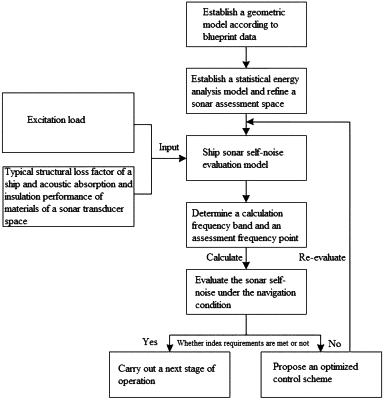| CPC G01S 15/006 (2013.01) [G06F 30/20 (2020.01)] | 9 Claims |

|
1. A method for evaluating sonar self-noise at a ship design stage to ensure a design of ship sonar system is low noise, comprising the following steps:
step S1: sorting out modeling parameters according to preset ship blueprint data, and building a scale geometric model according to the modeling parameters;
step S2: establishing a statistical energy evaluation model based on a statistical energy basic principle, and building a ship structure full-scale geometric simulation model and an acoustic cavity subsystem by using the scale geometric model;
step S3: acquiring loss factors and sonar transducer space outfitting acoustic absorption coefficient material parameters, wherein the loss factors comprise a structural loss factor and an acoustic cavity internal loss factor;
step S4: acquiring a mechanical excitation load, a hydrodynamic excitation load, and a propeller excitation load;
step S5: inputting the loss factors and the sonar transducer space outfitting acoustic absorption coefficient material parameters into the statistical energy evaluation model, and applying the mechanical excitation load to a face plate of foundation of the ship structure full-scale geometric simulation model, applying the hydrodynamic excitation load to the surface of a ship hull, and applying the propeller excitation load to a stern shaft to perform calculation of the sonar self-noise of the ship to obtain the total spectral density level of the sonar self-noise; and
step S6: evaluating spectral density level calculation results at 100 Hz, 1 kHz, and 10 kHz frequency points by preset index requirements, if the preset index requirements are not met, iteratively optimizing steps S3 to S6 before evaluation, and otherwise, carrying out a next stage of operation, wherein a risk level of sonar self-noise indexes at the ship design stage is evaluated based on the preset index requirements; wherein the risk is low when preset index requirements are met;
wherein the calculation of the sonar self-noise of the ship in step S5 specifically comprises: setting frequency response analysis to ⅓ octave frequency, setting a calculation frequency band to 100 Hz to 10 kHz, and performing calculation of the sonar self-noise of the ship; converting calculated acoustic pressure level results of each acoustic cavity obtained by division in the sonar transducer space into spectral density levels; and performing energy superposition on multiple spectral density level results to obtain the total spectral density level of the sonar self-noise.
|